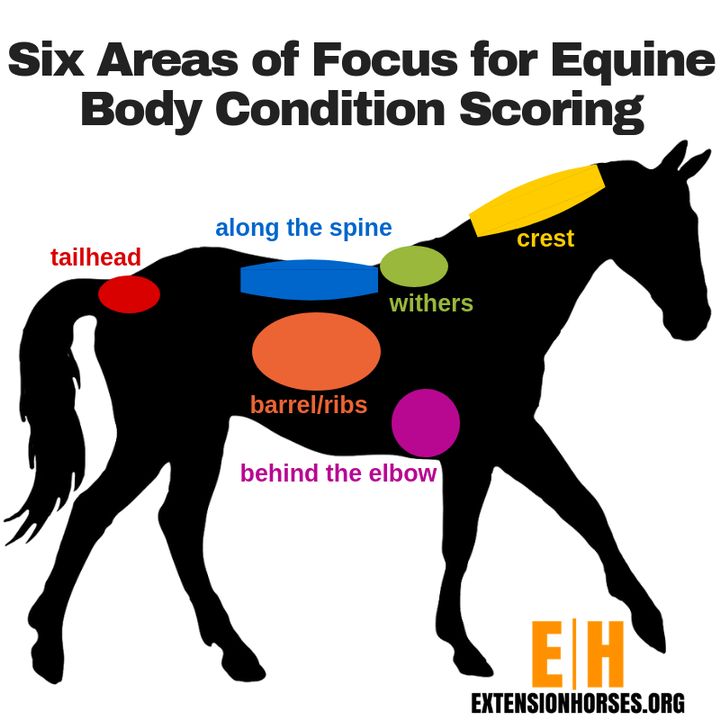Hay Everybody!
I’m waiting impatiently for someone to come let me out into the pasture. I can almost see the grass growing from here. I know this can be a dangerous time of year for me, though. I might lose my fine figure, if I’m not careful. And I definitely don’t want that to happen! I can already hear the laughter from my barn mates, including those cute mares in the next pasture over, if I were to lose my sleek physique. I decided I would use this time I spend waiting to educate myself on determining if I’m overweight, underweight, or just right and how to solve any problems with my weight.
One of the best ways to determine if your horse is carrying around a little extra weight is by assigning it a Body Condition Score or BCS for short. The BCS, developed by Dr. Henneke at Texas A&M University, is a scale ranging from 1 to 9 with 1 indicating your horse is severely underweight and 9 indicating your horse is severely overweight. To assign your horse a score, you assess the amount of fat covering on the horse’s ribs, neck, around the withers, over the loin, around the tailhead, and over the shoulder and elbow area. Most people score each individual area separately and then average the scores to obtain a final overall score. Evaluating your horse requires both visual inspection and hands-on assessment. For more information on how to assign your horse a body condition score, check out Extension publication. Most horses should fall somewhere between a 4 and 6 on the scale, depending on their job and level of fitness.

Photo credit: www.canr.msu.edu/news/body_condition_scoring_in_horses
Horses scoring a 3 or below need to gain weight. Under conditioned horses are more likely to have health problems and will underperform or not be able to perform the tasks asked of them. Poor condition can be a sign of an underlying health problem, so the first step in helping your horse gain weight is to have a veterinarian perform a complete physical exam to check for underlying problems including parasites. Older horses can also have trouble maintaining weight, so as your horse ages watch carefully for changes in weight and body condition. Weight loss is not the only issue facing older horses and you can check out more issues in the fact sheet on Caring for the Older Horse. No matter what the underlying cause is, the solution for an under conditioned horse is to increase its caloric intake after addressing the underlying cause. Calories in the horse’s diet are provided through carbohydrates, fats, and to some extent proteins. Carbohydrates are the primary source of calories or energy in the horse’s diet, so feeding energy dense feeds such as grains can increase the caloric content of the diet. Top-dressing with oil, a source of fat, is also a good way to add energy to a horse’s diet. Any changes should be introduced slowly and you should still follow good feeding practices such as those outlined in the Basics of Equine Nutrition fact sheet. Rehabilitating and refeeding a starved horse with a very low body condition score requires special precautions. You can learn more be watching a webinar on Refeeding the Starved Horse.
Horses scoring a BCS of 7 or above need to lose weight. Being obese or overweight leads to a multitude of problems for your horse. Carrying all that extra weight around stresses the joints and bones in your horses’ body and can make exercise difficult. Laminitis is another common concern for obese and overweight horses. Laminitis refers to disrupted blood flow and potential breakdown of the laminae within the horse’s hoof that hold the inner and outer portions of the hoof together. This condition is extremely painful and can cause lasting lameness problems for your horse. Overweight horses are also more likely to have equine metabolic syndrome or other metabolic issues like insulin resistance. Being turned out on lush pasture can worsen these problems in some horses. Just like any dietary change, the switch to pasture should be made slowly over a period of days to weeks. Diets high in non-structural carbohydrates, like the starches found in many grains, can also exacerbate metabolic conditions. Just as an underweight horse needs to gain weight, an overweight horse needs to lose weight. Weight loss can be achieved through a reduction in caloric intake, an increase in exercise, or both. Horses can be housed in a dry lot and placed on a diet of hay at 1.5%-2% of the horse’s target body weight. Most horses will eat this amount of hay quickly, so breaking it up into several feedings or using other practices to slow their consumption is a good idea. If horses need to remain on pasture, then a grazing muzzle can help you control their weight. Exercise programs should be implemented slowly to avoid overtaxing your horse and causing other problems. Some horses, referred to as “easy keepers” gain weight very easily. If this describes your horse, you’ll want to take steps to maintain your horse’s healthy weight after implementing a weight loss plan. You can find more tips in the fact sheet: Maintenance of the “Easy Keeper” Horse.
You should be prepared now to assess your horse’s body condition and determine if it needs to gain or lose some weight. It’s always a good idea to monitor and record your horse’s BCS on a regular basis, so you can monitor how changes in his routine, the weather, or your pasture are impacting your horse’s body condition. Perfect timing! I see someone coming down the lane to turn me out for the day. I’ll be sure to keep an eye on how much grass I’m consuming. Afterall, I don’t want to have to go on a diet or have my trim waistline explode!
Until next time!
Your Friend,

Lord Nelson
